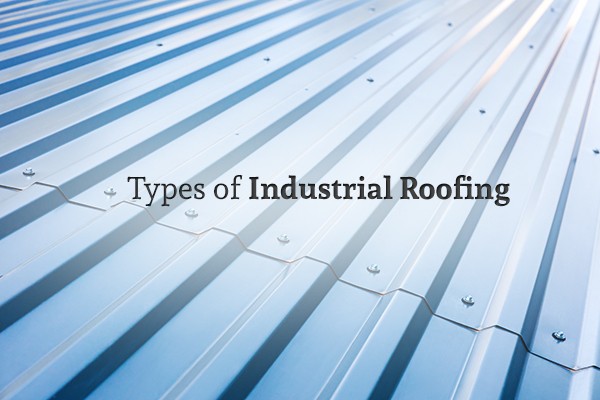
There are so many options for industrial roofing systems, from different styles to materials to application methods. Determining the best kind of roofing for an industrial building depends on several factors including the slope of the building’s roof, ventilation systems, and potential weather conditions. Here are the different types of industrial roofing and the benefits of each one.
1. Thermoplastic Polyolefin Roofing
Thermoplastic polyolefin (TPO) is a single-ply membrane roofing. Made up of a blend of ethylene, propylene, rubber, and fiberglass, TPO roofing membranes are manufactured in sheets that come in different sizes, including five, ten, twelve, and twenty feet wide.
TPO roofs are usually white in order to reflect sunlight and keep the building’s interior cooler. Now, advancements in the roofing industry have made it possible for TPO to come in other colors including greens, tans, and reds. This kind of roofing is usually installed on flat roofs.
Highly resistant to fat and oils, TPO is a great choice for restaurants and other places that emit oils from their ventilation systems. TPO’s benefits include:
- High durability
- Fire resistance
- Wind resistance
- UV resistance
- Resistance to chemical exposure
- Puncture resistance
- 20+ year lifespan
2. Thermoset Roof Membrane
Thermostat roofing—also known as EPDM roofing—is another kind of single-ply membrane roofing. Constructed from a rubbery material, it has been considered a reliable roofing option for many years. This type of roofing comes in both black and white and is generally used on low-slope buildings. EPDM roofs are sold in a wide range of widths, ranging from 7.5-50 feet, and in two thicknesses, 45 and 60 mils.
Installation involves either fully adhering the EPDM to the roof or mechanically attaching the EDPM system to the roof, sealing the seams of the roofing system with liquid adhesives or specially formulated tape.
Benefits of EPDM roofing include the following:
- Fire resistance
- Cold resistance
- UV resistance
- Acid resistance
- Alcohol and solvent resistance
- Easy installation, maintenance, and repair
3. Metal Roofs

Most people think of metal roofing when it comes to industrial buildings. Its high durability makes metal roofing an obvious choice for places requiring a strong defense against the elements. It is often installed on pitched roofs.
In the past, the biggest concerns about metal roofs were their susceptibility to rust and dents. Now, advancements in the industry mean most metal roofs are highly resistant to denting and can last up to 40 years without rusting.
Metal roofs are installed using either an exposed-fastener system or a hidden-fastener system. Hidden-fastener systems are more common due to their durability and distinct look of raised seams extending the full length of the panel.
Metal roofs come in a wide range of options including corrugated galvanized steel, stone-coated steel, aluminum, copper, tin, and stainless steel. Each kind has a different look and level of resistance to different kinds of damage.
Other benefits include:
- High fire resistance
- Versatility
- High durability
- Wind resistance
- Holds up well under snow
4. Built-Up Roofing
Built-up roofs (BUR) are named after their application method rather than the materials used to make them. Used for decades, this type of roofing is easily recognizable from its gravelly appearance. BUR roofing systems are applied in multiple layers, with base layers generally being tar or asphalt and a top layer of gravel. Built-up roofs can only be applied to a roof with little to no slope.
Benefits of BUR roofing include:
- Waterproof seal
- UV resistance
- Low maintenance
- High durability
- Low cost
5. Modified Bitumen

Sometimes regarded as built-up roofs due to their similar application method, modified bitumen roofs are also installed in roofs with little to no slope. Unlike built-up roofs, however, the layers in a modified bitumen roof are solid when applied, not liquid. Each layer is made up of bitumen, or naturally-occurring solid petroleum, mixed with another material such as fiberglass.
When installed, three-foot rolls are heated with a torch as the material is spread out on the surface of the roof. Like built-up roofing, a top layer of gravel usually covers modified bitumen roofing, providing extra protection against damage from UV rays.
Modified bitumen roofing is durable under heavy foot traffic, making it ideal for buildings that expect to have a lot of people walking on the roof.
Other benefits include the following:
- Resistance to severe weather conditions
- High durability
- Resistance to cracking during freezing temperatures
- Low maintenance
- Durable under heavy foot traffic
Quality Starts at the Top: Invest in High-Quality Industrial Roofing
If you need help choosing the best roofing material for your commercial building, contact Acme Roof Systems. Our roofing experts can help you choose the best roof and replace your current one with expert precision. With over 20 years of roofing experience, you can trust us to do it right.
FREE Roof Inspection
We offer transparent pricing with no hidden fees. Fill out the form below to request your free estimate today.
